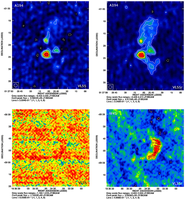Release of the VLA Low-frequency Sky Survey

The VLSSr covers the sky above declinations -30 deg at a frequency of 74 MHz with 75 arcsec resolution and an average rms noise of 0.1 Jy/beam. It includes six previously unpublished fields and improved dynamic range in 95% of all fields. The clean bias has been halved and is now 0.66x the local rms. The largest angular size imaged has been roughly doubled to 36 arcmin, and the number of cataloged sources is increased by 35% to 95,000.
Improvements made include application of a substantially more accurate primary beam correction, smart-windowing to reduce clean bias, and the use of new automatic radio frequency interference removal and bright-source peeling algorithms. We used the original VLSS as a starting sky model to enable higher-order Zernike fits to better model the ionospheric phase contributions.
Details of the improved reduction techniques can be found in W.M. Lane et al. (2012, Radio Science, 47, RS0K04) and a full description paper of the VLSSr is in preparation. Catalogs and images are on-line.




Connect with NRAO